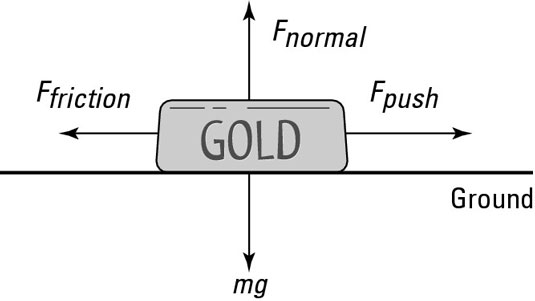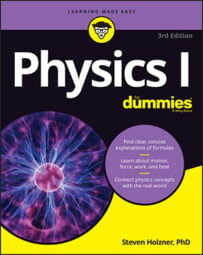Using physics, you can calculate the work required to move an object over a given distance. Motion is needed for work to be done. For work to be done, a net force has to move an object through a displacement. Work is a product of force and displacement.

Here’s an example: Say that you’re pushing a huge gold ingot home, as this figure shows. How much work do you have to do to get it home? To find work, you need to know both force and displacement. First, find out how much force pushing the ingot requires.
Suppose that the kinetic coefficient of friction,
between the ingot and the ground is 0.250 and that the ingot has a mass of 1,000 kilograms. What’s the force you have to exert to keep the ingot moving without accelerating it? Start with this equation for the force of friction:
Assuming that the road is flat, the magnitude of the normal force, FN, is just mg (mass times the acceleration due to gravity). That means that
where m is the mass of the ingot and g is the acceleration due to gravity on the surface of the Earth. Plugging in the numbers gives you the following:

You have to apply a force equal in magnitude to the force of friction (that is, 2,450 newtons) to keep the ingot moving without accelerating.
You know the force, so to find work, you need to know the displacement. Say that your house is 3 kilometers, or 3,000 meters, away. To get the ingot home, you have to do this much work:
Because you’re pushing the ingot with a force that’s parallel to the ground, the angle between F and s is 0 degrees, and cos 0 degrees = 1, so plugging in the numbers gives you the following:

You need to do 7.35 × 106 joules of work to move your ingot home. Want some perspective? Well, to lift 1 kilogram 1 meter straight up, you have to supply a force of 9.8 newtons (about 2.2 pounds) over that distance, which takes 9.8 joules of work. To get your ingot home, you need 750,000 times that. Put another way, 1 kilocalorie equals 4,186 joules. A kilocalorie is commonly called a Calorie (capital C) in nutrition; therefore, to move the ingot home, you need to expend about 1,755 Calories. Time to get out the energy bars!

